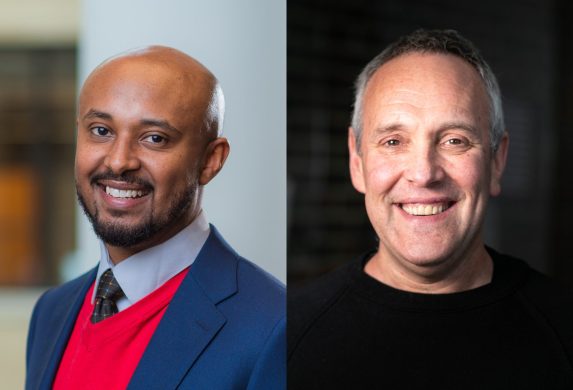Abate and Fink win 2024 Bose Grants

MIT Provost Cynthia Barnhart announced four Professor Amar G. Bose Research Grants to support bold research projects across diverse areas of study, including a way to generate clean hydrogen from deep in the Earth, build an environmentally friendly house of basalt, design maternity clothing that monitors fetal health, and recruit sharks as ocean oxygen monitors.
This year’s recipients are Iwnetim Abate, assistant professor of materials science and engineering; Andrew Babbin, the Cecil and Ida Green Associate Professor in Earth, Atmospheric and Planetary Sciences; Yoel Fink, professor of materials science and engineering and of electrical engineering and computer science; and Skylar Tibbits, associate professor of design research in the Department of Architecture.
The program was named for the visionary founder of the Bose Corporation and MIT alumnus Amar G. Bose ’51, SM ’52, ScD ’56. After gaining admission to MIT, Bose became a top math student and a Fulbright Scholarship recipient. He spent 46 years as a professor at MIT, led innovations in sound design, and founded the Bose Corp. in 1964. MIT launched the Bose grant program 11 years ago to provide funding over a three-year period to MIT faculty who propose original, cross-disciplinary, and often risky research projects that would likely not be funded by conventional sources.
“The promise of the Bose Fellowship is to help bold, daring ideas become realities, an approach that honors Amar Bose’s legacy,” says Barnhart. “Thanks to support from this program, these talented faculty members have the freedom to explore their bold and innovative ideas.”
Deep and clean hydrogen futures
A green energy future will depend on harnessing hydrogen as a clean energy source, sequestering polluting carbon dioxide, and mining the minerals essential to building clean energy technologies such as advanced batteries. Iwnetim Abate thinks he has a solution for all three challenges: an innovative hydrogen reactor.
He plans to build a reactor that will create natural hydrogen from ultramafic mineral rocks in the crust. “The Earth is literally a giant hydrogen factory waiting to be tapped,” Abate explains. “A back-of-the-envelope calculation for the first seven kilometers of the Earth’s crust estimates that there is enough ultramafic rock to produce hydrogen for 250,000 years.”
The reactor envisioned by Abate injects water to create a reaction that releases hydrogen, while also supporting the injection of climate-altering carbon dioxide into the rock, providing a global carbon capacity of 100 trillion tons. At the same time, the reactor process could provide essential elements such as lithium, nickel, and cobalt — some of the most important raw materials used in advanced batteries and electronics.
“Ultimately, our goal is to design and develop a scalable reactor for simultaneously tapping into the trifecta from the Earth’s subsurface,” Abate says.
Sharks as oceanographers
If we want to understand more about how oxygen levels in the world’s seas are disturbed by human activities and climate change, we should turn to a sensing platform “that has been honed by 400 million years of evolution to perfectly sample the ocean: sharks,” says Andrew Babbin.
As the planet warms, oceans are projected to contain less dissolved oxygen, with impacts on the productivity of global fisheries, natural carbon sequestration, and the flux of climate-altering greenhouse gasses from the ocean to the air. While scientists know dissolved oxygen is important, it has proved difficult to track over seasons, decades, and underexplored regions both shallow and deep.
Babbin’s goal is to develop a low-cost sensor for dissolved oxygen that can be integrated with preexisting electronic shark tags used by marine biologists. “This fleet of sharks … will finally enable us to measure the extent of the low-oxygen zones of the ocean, how they change seasonally and with El Niño/La Niña oscillation, and how they expand or contract into the future.”
The partnership with sharks will also spotlight the importance of these often-maligned animals for global marine and fisheries health, Babbin says. “We hope in pursuing this work marrying microscopic and macroscopic life we will inspire future oceanographers and conservationists, and lead to a better appreciation for the chemistry that underlies global habitability.”
Maternity wear that monitors fetal health
There are 2 million stillbirths around the world each year, and in the United States alone, 21,000 families suffer this terrible loss. In many cases, mothers and their doctors had no warning of any abnormalities or changes in fetal health leading up to these deaths. Yoel Fink and colleagues are looking for a better way to monitor fetal health and provide proactive treatment.
Fink is building on years of research on acoustic fabrics to design an affordable shirt for mothers that would monitor and communicate important details of fetal health. His team’s original research drew inspiration from the function of the eardrum, designing a fiber that could be woven into other fabrics to create a kind of fabric microphone.
“Given the sensitivity of the acoustic fabrics in sensing these nanometer-scale vibrations, could a mother’s clothing transcend its conventional role and become a health monitor, picking up on the acoustic signals and subsequent vibrations that arise from her unborn baby’s heartbeat and motion?” Fink says. “Could a simple and affordable worn fabric allow an expecting mom to sleep better, knowing that her fetus is being listened to continuously?”
The proposed maternity shirt could measure fetal heart and breathing rate, and might be able to give an indication of the fetal body position, he says. In the final stages of development, he and his colleagues hope to develop machine learning approaches that would identify abnormal fetal heart rate and motion and deliver real-time alerts.
A basalt house in Iceland
In the land of volcanoes, Skylar Tibbits wants to build a case-study home almost entirely from the basalt rock that makes up the Icelandic landscape.
Architects are increasingly interested in building using one natural material — creating a monomaterial structure — that can be easily recycled. At the moment, the building industry represents 40 percent of carbon emissions worldwide, and consists of many materials and structures, from metal to plastics to concrete, that can’t be easily disassembled or reused.
The proposed basalt house in Iceland, a project co-led by J. Jih, associate professor of the practice in the Department of Architecture, is “an architecture that would be fully composed of the surrounding earth, that melts back into that surrounding earth at the end of its lifespan, and that can be recycled infinitely,” Tibbits explains.
Basalt, the most common rock form in the Earth’s crust, can be spun into fibers for insulation and rebar. Basalt fiber performs as well as glass and carbon fibers at a lower cost in some applications, although it is not widely used in architecture. In cast form, it can make corrosion- and heat-resistant plumbing, cladding and flooring.
“A monomaterial architecture is both a simple and radical proposal that unfortunately falls outside of traditional funding avenues,” says Tibbits. “The Bose grant is the perfect and perhaps the only option for our research, which we see as a uniquely achievable moonshot with transformative potential for the entire built environment.”

